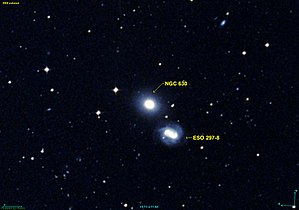NGC 630
| Galaxy NGC 630 |
|
|---|---|

|
|
| AladinLite | |
| Constellation | sculptor |
|
Position equinox : J2000.0 , epoch : J2000.0 |
|
| Right ascension | 01 h 35 m 36.5 s |
| declination | -39 ° 21 ′ 28 ″ |
| Appearance | |
| Morphological type | E. |
| Brightness (visual) | 11.9 likes |
| Brightness (B-band) | 12.9 mag |
| Angular expansion | 1.6 ′ × 1.4 ′ |
| Position angle | 60 ° |
| Surface brightness | 12.8 mag / arcmin² |
| Physical data | |
| Redshift | 0.019760 ± 0.000063 |
| Radial velocity | 5924 ± 19 km / s |
|
Stroke distance v rad / H 0 |
(262 ± 18) · 10 6 ly (80.2 ± 5.6) Mpc |
| history | |
| discovery | John Herschel |
| Discovery date | October 23, 1835 |
| Catalog names | |
| NGC 630 • PGC 5924 • ESO 297-009 • MCG -07-04-020 • 2MASX J01353647-3921283 • SGC 013325-3936.9 • GC 374 • h 2428 • AM 0133-393 • LDCE 0097 NED004 | |
NGC 630 is an elliptical galaxy of Hubble type E / S0 in the constellation Sculptor at the southern sky . It is estimated to be 262 million light-years from the Milky Way and about 125,000 light years in diameter.
The galaxy NGC 626 is located in the same area of the sky .
The object was discovered on October 23, 1835 by the British astronomer John Herschel .
Web links
- SIMBAD Astronomical Database
- Auke Slotegraaf: NGC 630. Deep Sky Observer's Companion, accessed on September 3, 2015 .
